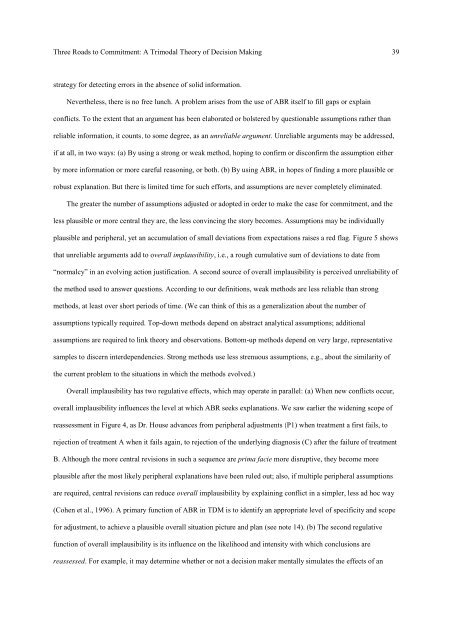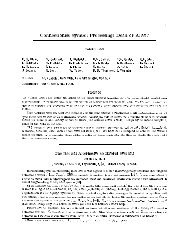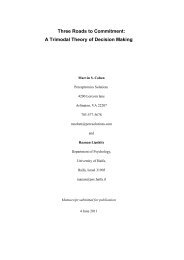Three Roads to Commitment: A Trimodal Theory of Decision Making
Three Roads to Commitment: A Trimodal Theory of Decision Making
Three Roads to Commitment: A Trimodal Theory of Decision Making
You also want an ePaper? Increase the reach of your titles
YUMPU automatically turns print PDFs into web optimized ePapers that Google loves.
<strong>Three</strong> <strong>Roads</strong> <strong>to</strong> <strong>Commitment</strong>: A <strong>Trimodal</strong> <strong>Theory</strong> <strong>of</strong> <strong>Decision</strong> <strong>Making</strong> 39<br />
strategy for detecting errors in the absence <strong>of</strong> solid information.<br />
Nevertheless, there is no free lunch. A problem arises from the use <strong>of</strong> ABR itself <strong>to</strong> fill gaps or explain<br />
conflicts. To the extent that an argument has been elaborated or bolstered by questionable assumptions rather than<br />
reliable information, it counts, <strong>to</strong> some degree, as an unreliable argument. Unreliable arguments may be addressed,<br />
if at all, in two ways: (a) By using a strong or weak method, hoping <strong>to</strong> confirm or disconfirm the assumption either<br />
by more information or more careful reasoning, or both. (b) By using ABR, in hopes <strong>of</strong> finding a more plausible or<br />
robust explanation. But there is limited time for such efforts, and assumptions are never completely eliminated.<br />
The greater the number <strong>of</strong> assumptions adjusted or adopted in order <strong>to</strong> make the case for commitment, and the<br />
less plausible or more central they are, the less convincing the s<strong>to</strong>ry becomes. Assumptions may be individually<br />
plausible and peripheral, yet an accumulation <strong>of</strong> small deviations from expectations raises a red flag. Figure 5 shows<br />
that unreliable arguments add <strong>to</strong> overall implausibility, i.e., a rough cumulative sum <strong>of</strong> deviations <strong>to</strong> date from<br />
“normalcy” in an evolving action justification. A second source <strong>of</strong> overall implausibility is perceived unreliability <strong>of</strong><br />
the method used <strong>to</strong> answer questions. According <strong>to</strong> our definitions, weak methods are less reliable than strong<br />
methods, at least over short periods <strong>of</strong> time. (We can think <strong>of</strong> this as a generalization about the number <strong>of</strong><br />
assumptions typically required. Top-down methods depend on abstract analytical assumptions; additional<br />
assumptions are required <strong>to</strong> link theory and observations. Bot<strong>to</strong>m-up methods depend on very large, representative<br />
samples <strong>to</strong> discern interdependencies. Strong methods use less strenuous assumptions, e.g., about the similarity <strong>of</strong><br />
the current problem <strong>to</strong> the situations in which the methods evolved.)<br />
Overall implausibility has two regulative effects, which may operate in parallel: (a) When new conflicts occur,<br />
overall implausibility influences the level at which ABR seeks explanations. We saw earlier the widening scope <strong>of</strong><br />
reassessment in Figure 4, as Dr. House advances from peripheral adjustments (P1) when treatment a first fails, <strong>to</strong><br />
rejection <strong>of</strong> treatment A when it fails again, <strong>to</strong> rejection <strong>of</strong> the underlying diagnosis (C) after the failure <strong>of</strong> treatment<br />
B. Although the more central revisions in such a sequence are prima facie more disruptive, they become more<br />
plausible after the most likely peripheral explanations have been ruled out; also, if multiple peripheral assumptions<br />
are required, central revisions can reduce overall implausibility by explaining conflict in a simpler, less ad hoc way<br />
(Cohen et al., 1996). A primary function <strong>of</strong> ABR in TDM is <strong>to</strong> identify an appropriate level <strong>of</strong> specificity and scope<br />
for adjustment, <strong>to</strong> achieve a plausible overall situation picture and plan (see note 14). (b) The second regulative<br />
function <strong>of</strong> overall implausibility is its influence on the likelihood and intensity with which conclusions are<br />
reassessed. For example, it may determine whether or not a decision maker mentally simulates the effects <strong>of</strong> an




